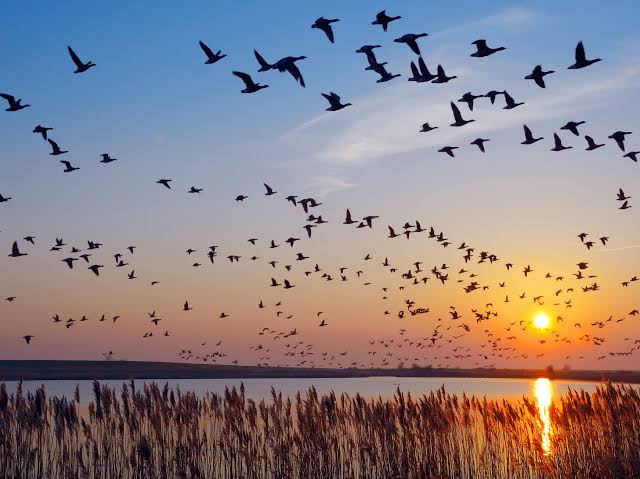India, the land of flora and fauna, sees a huge migration of birds every year due to its balanced season. However, this year, Chandigarh Bird Club (CBC) saw a decline in the number of species of migratory birds in its wetlands. The club records the number of birds that flock here twice a year, February and November.
According to its November survey, when the arrival of migratory birds is considered to be completed, there has been a steady decline in the species of birds. According to the census, only 98 species flocked in 2018, 91 species in 2017, 86 species in 2019, and 77 species in 2020 respectively.
In February 2021, only 368 Waterfowl birds were spotted. It was 734 in 2020 and 850 in 2018 with 31 species.
Let’s understand the details of it:-
What are migratory birds?
Birds fly from one region to another, one country to another, one hemisphere to another in search of favourable season, breeding, food, and mortality. Such birds that do this regularly are known as migratory birds. They navigate using celestial cues from the sun and stars, earth’s magnetic field, and mental maps.
Which birds migrate to India?
There are a number of foreign birds that find shelter in India. At least 229 species of birds have been arriving in the country for a long time. Asiatic Sparrow-Hawk, Harriers, Peregrine Falcon, Osprey, Pacific Golden Plover, Graylag Goose, Bar-headed Goose, Northern Shoveller, Common Pochard, Tufted Duck, are some of the species that touch down various parts of the country.
Birds like Bar-headed Goose fly over the Himalayas to reach India, while Wagtails, the African bird, are one of the early arrivals in India during the winter season. Rock Thrush too, migrates from the south of the Himalayas after leaving Siberia to the Western Ghats and hilly areas in the country.
Why has the number of migratory birds in the country declined?
-Global decline in the population of birds: The population of migratory birds, even in their native country is on a decline. According to the State of India’s Birds 2020 report, the number of eagles, vultures, warblers, and migrating shorebirds has declined in the country. According to the same report, the population of migratory birds, both long-distance and within the subcontinent has also shown a “steep decline”.
Of the 261 species on which data is available, 52% had declined in numbers. The decline has been attributed to the loss of habitat and hunting.
-Hunting and poaching: One reason why birds migrate is predation. However, they meet the same fate in the late they migrate to. According to the thirteenth conference of parties (COP-13) report on conservation of migratory species (CMS) of wild animals in Gandhinagar, the biggest threat for migratory species at extinction are hunting, poaching, persecution, and control. 94% of birds face this fate.
- Human footprints: Increased interference of human beings and disturbance around the habitats of birds can be a reason why bird’s numbers have declined. The same CMS report showed that over 70 % of the migratory species in Appendix 1 are declining along with habitat loss.
- The declining condition of climate, ecology, and emission of greenhouse gases.
What does it mean for the ecosystem?
Birds perform a number of activities that are advantageous to the ecology, like controlling pests in farms, promoting pollination of flowers and fruits, seed dispersal, and forest regeneration. They also help in cleaning the environment by eating on the dead. Moreover, they help in striking a balance in the environment and also add to natural beauty in the world.
The decline of birds or migratory birds would mean disruption in all these activities and harm to the ecological balance.
What is the Government of India doing?
-The government of India has drafted a 10-year plan, Visionary perspective plan (2020-2030) that aims to protect birds and conserve their habitat, including those of the migratory birds coming to India. The draft proposes steps to protect migratory birds, conserve wetlands and focus on birds in urban areas.
-The National Wildlife Action Plan (2017-2031) also protects and conserves birds and their habitats.
-The Ministry of Environment, Forest and Climate Change, MoEFCC’s India’s National Action Plan for Conservation of Migratory Birds and their Habitats along the Central Asian Flyway (2018-2023) aims to protect these birds.






















 WhatsApp us
WhatsApp us
Pingback: Board of Trustees
Pingback: افضل جامعة لدراسة ادارة الاعمال
Pingback: الصيدلانيات والتكنولوجيا الصيدلانية
Pingback: https://www.kooky.domains/post/the-role-of-web3-domains-in-decentralized-finance-defi
Pingback: https://www.kooky.domains/post/transitioning-from-traditional-domains-to-web3-domains
Pingback: درجات البكالوريوس في الموارد البشرية
Pingback: البحث العلمي
Pingback: فرص العمل لكلية الصيدلة
Pingback: Lifelong learning opportunities for students
Pingback: Technical Writer
Pingback: Dr. Khaled Azazy
Pingback: برامج الإقامة الخاصة بتقويم الأسنان
Pingback: Transfer students admissions to future university
Pingback: Maillot de football
Pingback: Maillot de football
Pingback: Maillot de football
Pingback: Maillot de football
Pingback: Boerefijn Tech
Pingback: led controsoffitto
Pingback: entraînement ninja warrior
Pingback: hack squat
Pingback: Fiverr Earn
Pingback: Fiverr Earn
Pingback: Fiverr Earn
Pingback: fiverrearn.com
Pingback: fiverrearn.com
Pingback: prodentim
Pingback: shipping broker
Pingback: french bulldog puppies
Pingback: fiverrearn.com
Pingback: blue french bulldog
Pingback: jute vs sisal rug
Pingback: Sem
Pingback: teacup french bulldog for sale
Pingback: french bulldog
Pingback: black french bulldog
Pingback: fluffy french bulldog
Pingback: brindle french bulldog
Pingback: french bulldog for sale tx
Pingback: Personalised bracelet
Pingback: best Phone
Pingback: future university
Pingback: future university
Pingback: future university
Pingback: slot nexus
Pingback: rent a golf cart on isla mujeres
Pingback: top university Egypt
Pingback: Piano repair specialists
Pingback: Upright piano storage
Pingback: Local movers
Pingback: Commercial moving
Pingback: برنامج ادارة الاعمال بمصر
Pingback: Classic Books 500
Pingback: Streamer
Pingback: How to start a camgirl in Australia
Pingback: pupuk anorganik cair
Pingback: puradrop supplement
Pingback: actiflow prostate
Pingback: puravive where to buy
Pingback: Economics
Pingback: التحصينات
Pingback: french pitbull puppies
Pingback: Queen Arwa University
Pingback: Kampus Islam Terbaik
Pingback: FiverrEarn
Pingback: FiverrEarn
Pingback: Generator Service Leeds
Pingback: cheap sex cams
Pingback: rare breed-trigger
Pingback: 늑대닷컴
Pingback: Expanding symbol
Pingback: freelance web designer Singapore
Pingback: allgame
Pingback: หวย24
Pingback: Skincare for blemishes
Pingback: pg slot
Pingback: aplikasi admin slot pragmatic
Pingback: hotel in windham ny
Pingback: 35 whelen ammo
Pingback: cybersecurite salaire
Pingback: nz jobs
Pingback: karachi jobs